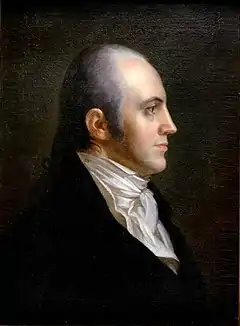8th United States Congress
The 8th United States Congress was a meeting of the legislative branch of the United States federal government, consisting of the United States Senate and the United States House of Representatives. It met in Washington, D.C. from March 4, 1803, to March 4, 1805, during the last two years of Thomas Jefferson's first term in office. The apportionment of seats in the House of Representatives was based on the 1800 United States census. Both chambers had a Democratic-Republican majority.
| 8th United States Congress | |
|---|---|
7th ← → 9th | |
 United States Capitol (1800) | |
March 4, 1803 – March 4, 1805 | |
| Members | 34 senators 142 representatives 1 non-voting delegates |
| Senate majority | Democratic-Republican |
| Senate President | Aaron Burr (DR) |
| House majority | Democratic-Republican |
| House Speaker | Nathaniel Macon (DR) |
| Sessions | |
| 1st: October 17, 1803 – March 27, 1804 2nd: November 5, 1804 – March 3, 1805 | |
Major events

- April 30, 1803: Louisiana Purchase was made by the United States from France
- February 16, 1804: In the First Barbary War, Stephen Decatur led a raid to burn the pirate-held frigate Philadelphia
- May 14, 1804: Lewis and Clark Expedition departed from Camp Dubois to begin their historic journey by traveling up the Missouri River
- July 11, 1804: Aaron Burr killed Alexander Hamilton
- November 30, 1804: Impeachment trial of Supreme Court Justice Samuel Chase
- December 3, 1804: 1804 United States presidential election: Incumbent Thomas Jefferson (DR) beat challenger Charles Cotesworth Pinckney (F)
- March 1, 1805: Samuel Chase acquitted of impeachment charges by the U.S. Senate
Major legislation
Constitutional amendments
- December 9, 1803: Approved an amendment to the United States Constitution providing a new procedure for electing the President and Vice President, and submitted it to the state legislatures for ratification 2 Stat. 306
- June 15, 1804: Twelfth Amendment was ratified by the requisite number of states (then 13) to become part of the Constitution
Treaties
- October 20, 1803: Senate ratified the Louisiana Purchase Treaty
Territories organized
- March 26, 1804: Territory of Orleans was organized from the portion of the Louisiana Purchase south of the 33rd parallel; the portion north of the 33rd parallel was organized as the District of Louisiana. 2 Stat. 283
- January 11, 1805: Michigan Territory was organized. 2 Stat. 309
- March 3, 1805: Louisiana Territory was organized from the District of Louisiana. 2 Stat. 331
Party summary
The count below identifies party affiliations at the beginning of the first session of this Congress, and includes members from vacancies and newly admitted states, when they were first seated. Changes resulting from subsequent replacements are shown below in the "Changes in membership" section.
Senate
| Party (shading shows control) |
Total | Vacant | ||
|---|---|---|---|---|
| Democratic- Republican (DR) |
Federalist (F) | |||
| End of previous congress | 18 | 14 | 32 | 2 |
| Begin | 21 | 9 | 30 | 4 |
| End | 25 | 34 | 0 | |
| Final voting share | 73.5% | 26.5% | ||
| Beginning of next congress | 27 | 7 | 34 | 0 |
House of Representatives
Following the 1800 census, the size of the House was increased to 142 seats from 108.
| Party (shading shows control) |
Total | Vacant | ||
|---|---|---|---|---|
| Democratic- Republican (DR) |
Federalist (F) | |||
| End of previous congress | 64 | 41 | 105 | 3 |
| Begin | 100 | 39 | 139 | 3 |
| End | 101 | 140 | 2 | |
| Final voting share | 72.1% | 27.9% | ||
| Beginning of next congress | 113 | 26 | 139 | 3 |
Leadership

Senate
- President: Aaron Burr (DR)
- President pro tempore: John Brown (DR), October 17, 1803 – February 26, 1804
- Jesse Franklin (DR), March 10, 1804 – November 4, 1804
- Joseph Anderson (DR), January 15, 1805 – December 1, 1805
House of Representatives
- Speaker: Nathaniel Macon (DR)
Members
This list is arranged by chamber, then by state. Senators are listed in order of seniority, and representatives are listed by district.
Senate
Senators were elected by the state legislatures every two years, with one-third beginning new six-year terms with each Congress. Preceding the names in the list below are Senate class numbers, which indicate the cycle of their election. In this Congress, Class 1 meant their term began with this Congress, requiring reelection in 1808; Class 2 meant their term ended in this Congress, requiring reelection in 1804; and Class 3 meant their term began in the last Congress, requiring reelection in 1806.
Connecticut
Delaware
Georgia
Kentucky
Maryland
Massachusetts
New Hampshire
New Jersey
New York
North Carolina
|
Ohio
Pennsylvania
Rhode Island
South Carolina
Tennessee
Vermont
Virginia
|
 Senators' party membership by state at the opening of the 8th Congress in March 1803.
2 Democratic-Republicans
1 Democratic-Republican and 1 Federalist
2 Federalists
|
House of Representatives
The names of members of the House of Representatives are preceded by their district numbers.
Changes in membership
The count below reflects changes from the beginning of the first session of this Congress.
Senate
| State (class) |
Vacated by | Reason for change | Successor | Date of successor's formal installation[lower-alpha 1] |
|---|---|---|---|---|
| Ohio (1) |
Vacant | Failure to elect | John Smith (DR) | Seated April 1, 1803 |
| Ohio (3) |
Vacant | Failure to elect | Thomas Worthington (DR) | Seated April 1, 1803 |
| New Jersey (1) |
Vacant | Failure to elect | John Condit (DR) | Seated September 1, 1803 |
| Tennessee (1) |
Vacant | Failure to elect | Joseph Anderson (DR) | Elected September 22, 1803 |
| Virginia (1) |
Stevens T. Mason (DR) | Died May 10, 1803 | John Taylor (DR) | Appointed June 4, 1803 |
| New York (3) |
DeWitt Clinton (DR) | Resigned November 4, 1803, to become Mayor of New York City | John Armstrong Jr. (DR) | Appointed December 7, 1803 |
| Virginia (1) |
John Taylor (DR) | Successor elected December 7, 1803 | Abraham B. Venable (DR) | Elected December 7, 1803 |
| New York (1) |
Theodorus Bailey (DR) | Resigned January 16, 1804, to become Postmaster of New York City | John Armstrong Jr. (DR) | Seated February 25, 1804 |
| New York (3) |
John Armstrong Jr. (DR) | Successor elected February 23, 1804 | John Smith (DR) | Elected February 23, 1804 |
| Virginia (2) |
Wilson C. Nicholas (DR) | Resigned May 22, 1804, to become Collector of Port of Norfolk | Andrew Moore (DR) | Appointed August 11, 1804 |
| Virginia (1) |
Abraham B. Venable (DR) | Resigned June 7, 1804 | William B. Giles (DR) | Appointed August 11, 1804 |
| New York (1) |
John Armstrong Jr. (DR) | Resigned June 30, 1804, after being appointed Minister to France | Samuel Latham Mitchill (DR) | Seated November 23, 1804 |
| Rhode Island (1) |
Samuel J. Potter (DR) | Died October 14, 1804 | Benjamin Howland (DR) | Seated October 29, 1804 |
| Delaware (2) |
William H. Wells (F) | Resigned November 6, 1804 | James A. Bayard (F) | Seated November 13, 1804 |
| South Carolina (3) |
Pierce Butler (DR) | Resigned November 21, 1804 | John Gaillard (DR) | Seated December 6, 1804 |
| Virginia (1) |
William B. Giles (DR) | Successor elected December 4, 1804 | Andrew Moore (DR) | Elected December 4, 1804 |
| Virginia (2) |
Andrew Moore (DR) | Successor elected December 4, 1804 | William B. Giles (DR) | Elected December 4, 1804 |
House of Representatives
| District | Vacated by | Reason for change | Successor | Date of successor's formal installation[lower-alpha 1] |
|---|---|---|---|---|
| New York 7th |
Vacant | John Cantine (DR) was elected, but resigned before the Congress began. | Josiah Hasbrouck (DR) | October 17, 1803 |
| Connecticut at-large | Vacant | Incumbent Elias Perkins (F) elected but chose not to serve. Successor elected September 5, 1803. |
Simeon Baldwin (F) | October 17, 1803 |
| Ohio at-large | Vacant | Seat vacant following Ohio's admission to Union until special election held on June 21, 1803. | Jeremiah Morrow (DR) | October 17, 1803 |
| New York 6th |
Isaac Bloom (DR) | Died April 26, 1803 | Daniel C. Verplanck (DR) | October 17, 1803 |
| New York 1st |
John Smith (DR) | Resigned February 23, 1804, after being elected to U.S. Senate | Samuel Riker (DR) | November 5, 1804 |
| Virginia 5th |
Thomas Lewis Jr. (F) | Lost contested election March 5, 1804 | Andrew Moore (DR) | March 5, 1804 |
| Maryland 4th |
Daniel Hiester (DR) | Died March 7, 1804 | Roger Nelson (DR) | November 6, 1804 |
| Virginia 13th |
John J. Trigg (DR) | Died May 17, 1804 | Christopher H. Clark (DR) | November 5, 1804 |
| Massachusetts 12th |
Thomson J. Skinner (DR) | Resigned August 10, 1804 | Simon Larned (DR) | November 5, 1804 |
| Virginia 5th |
Andrew Moore (DR) | Resigned August 11, 1804, after being appointed to U.S. Senate | Alexander Wilson (DR) | December 4, 1804 |
| Pennsylvania 10th |
William Hoge (DR) | Resigned October 15, 1804 | John Hoge (DR) | November 2, 1804 |
| New York 3rd |
Samuel L. Mitchill (DR) | Resigned November 22, 1804, after being elected to U.S. Senate | George Clinton Jr. (DR) | February 14, 1805 |
| North Carolina 5th |
James Gillespie (DR) | Died January 11, 1805 | Vacant | Not filled for remainder of term |
| Georgia at-large |
Samuel Hammond (DR) | Resigned February 2, 1805, after becoming Civil and Military Governor of the Upper Louisiana Territory | Vacant | Not filled for remainder of term |
Committees
Lists of committees and their party leaders.
Senate
House of Representatives
- Claims (Chairman: John C. Smith then Samuel W. Dana)
- Commerce and Manufactures (Chairman: Samuel L. Mitchill)
- Elections (Chairman: William Findley)
- Revisal and Unfinished Business (Chairman: Samuel Tenney)
- Rules (Select)
- Standards of Official Conduct
- Ways and Means (Chairman: John Randolph)
- Whole
Joint committees
- Enrolled Bills (Chairman: N/A)
Officers
Legislative branch agency directors
- Architect of the Capitol: Benjamin H. Latrobe, appointed March 6, 1803
- Librarian of Congress: John J. Beckley
Senate
- Secretary: Samuel A. Otis
- Sergeant at Arms: James Mathers
- Chaplain: Edward Gantt, Episcopalian, until November 7, 1804
- Alexander T. McCormick, Episcopalian, elected November 7, 1804
House of Representatives
- Clerk: John Beckley
- Sergeant at Arms: Joseph Wheaton
- Doorkeeper: Thomas Claxton
- Chaplain: William Parkinson, Baptist, until November 5, 1804
- The Rev. James Laurie, Presbyterian, elected November 5, 1804
- Reading Clerks: [data missing]
See also
- 1802 United States elections (elections leading to this Congress)
- 1804 United States elections (elections during this Congress, leading to the next Congress)
Notes
- When seated or oath administered, not necessarily when service began.
References
- Martis, Kenneth C. (1989). The Historical Atlas of Political Parties in the United States Congress. New York: Macmillan Publishing Company.
- Martis, Kenneth C. (1982). The Historical Atlas of United States Congressional Districts. New York: Macmillan Publishing Company.